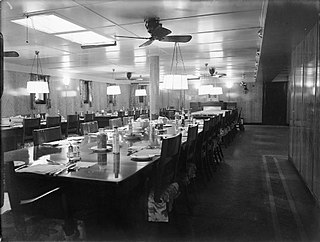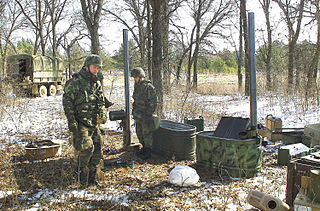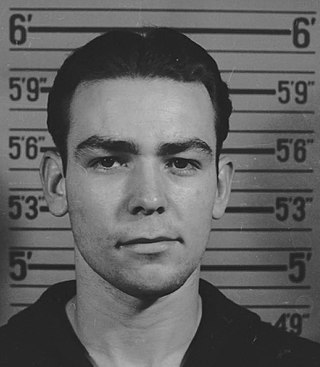
A non-commissioned officer (NCO) is a military officer who does not hold a commission. Non-commissioned officers usually earn their position of authority by promotion through the enlisted ranks. In contrast, commissioned officers usually enter directly from a military academy, officer training corps (OTC) or reserve officer training corps (ROTC), or officer candidate school (OCS) or officer training school (OTS), after receiving a post-secondary degree.

Doris "Dorie" Miller was an American Naval cook who was the first Black recipient of the Navy Cross and a nominee for the Medal of Honor. As a mess attendant second class in the United States Navy, Miller helped carry wounded sailors to safety during the attack on Pearl Harbor. He then manned an anti-aircraft gun and, despite no prior training in gunnery, officially shot down one plane but Doris and other eye witnesses claimed the ranges of four to six.

Command master chief petty officer (CMDCM) is an enlisted rating in the United States Navy and U.S. Coast Guard, as well as the Japan Maritime Self-Defense Force.
Petty officer first class (PO1) is a rank found in some navies and maritime organizations.

The wardroom is the mess cabin or compartment on a warship or other military ship for commissioned naval officers above the rank of midshipman. Although the term typically applies to officers in a navy, it is also applicable to marine officers and coast guard officers in those nations that have such service branches. On larger vessels, such as aircraft carriers of the United States Navy, there may be more than one wardroom. It may also be used on stone frigates to refer to similar officer mess facilities at naval, marine, and coast guard installations ashore.

The mess is a designated area where military personnel socialize, eat and live. The term is also used to indicate the groups of military personnel who belong to separate messes, such as the officers' mess, the chief petty officer mess, and the enlisted mess. In some civilian societies this military usage has been extended to the eating arrangements of other disciplined services such as fire fighting and police forces.

The surface warfare insignia is a military badge of the United States Navy which is issued to U.S. Navy personnel who are trained and qualified to perform duties aboard United States surface warships. There are presently four classes of the surface warfare pin, being that of line, staff, special operations, and enlisted. The line and enlisted surface warfare badges may be earned by United States Coast Guard personnel assigned to Navy commands. The various badge types are as follows:
The Enlisted Aviation Warfare Specialist (EAWS) insignia is a military badge of the United States Navy which was created in March 1980. The insignia recognizes those members of the Navy's enlisted force who have acquired the specific professional skills, knowledge, and military experience that result in qualification for service in the aviation activities of the Navy. This includes most personnel who are trained flight deck personnel onboard aircraft carriers, or maintenance personnel at an Aircraft Intermediate Maintenance Detachment or Department (AIMD) or aircraft squadron.

Storekeeper (SK) is an enlisted rating in the United States Coast Guard; until 2009 it was also a United States Navy rating, the most common supply rate in U.S. Navy vs. CS and SH and very much equivalent to the MOS 92 of the U.S. Army. In the Navy this rating, together with PC, has been renamed or superseded by the rating logistics specialist (LS).

KP duty means "kitchen police" or "kitchen patrol" work under the kitchen staff assigned to junior U.S. enlisted military personnel. "KP" can be either the work or the personnel assigned to perform such work. In the latter sense it can be used for either military or civilian personnel assigned or hired for duties in the military dining facility excluding cooking.

The United States Navy occupational rating of boatswain's mate is a designation given by the Bureau of Naval Personnel (BUPERS) to enlisted members who were rated or "striking" for the rating as a deck seaman. The colloquial form of address for a boatswain's mate is "Boats".

Forrest O. Rednour (1923–1943) was a United States Coast Guardsman who received the Navy and Marine Corps Medal posthumously for his actions during World War II.
Chief Petty Officer (CPO) is the seventh enlisted rank in the United States Navy and U.S. Coast Guard, is above Petty Officer First Class and below Senior Chief Petty Officer. The term "rating" is used to identify enlisted job specialties. In this way, enlisted personnel are segregated into three segments containing different enlisted ranks. Furthermore, rates are broken down into three levels: non-rated members without a designated occupation. Advancement to E-4 and above is dependent on graduating from a specialty school that define what the enlisted is rated for. Petty officers and chief petty officers are part of the rated force and considered extremely knowledgeable about their particular rating. Examples include Culinary Services Chief and Aviation Maintenance Chief. The Chief Petty Officer is the rank. Gunners Mate is a rating. E7 is a pay grade. The term rating is used to identify the career field of a chief petty officer. For example, the title of a chief petty officer in the Master-at-Arms rating would be spoken or spelled out as Chief Master-at-Arms. The title would be abbreviated MAC. The grade of chief petty officer was established on 1 April 1893 in the United States Navy. The United States Congress first authorized the Coast Guard to use the promotion to Chief Petty Officer on 18 May 1920. Chief petty officer is also the final cadet grade in the United States Naval Sea Cadet Corps.

A sailor, seaman, mariner, or seafarer is a person who works aboard a watercraft as part of its crew, and may work in any one of a number of different fields that are related to the operation and maintenance of a ship.
Melvin Kealoha Bell Sr. (1920–2018) was a sailor who served in the United States Coast Guard, and was the first Pacific Island sailor in the Coast Guard to be promoted to the rank of chief petty officer.

Oliver Henry was a Coast Guardsman who served from 1940 to 1966 in the United States Coast Guard. When Henry started serving in the Coast Guard, the United States Armed Forces were still racially segregated so he served as a mess steward, an all black rating. He was the first black to transfer from the mess steward rating. He was transferred to the motor machinist mate rating – related to his pre-service work as an auto mechanic.














